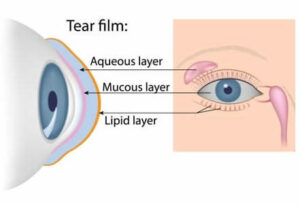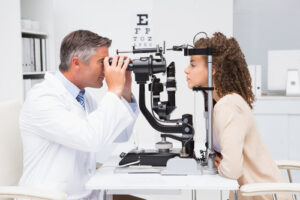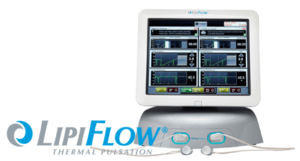Do you find yourself experiencing feelings like you have something stuck in your eye that you can’t seem to get out? After a long workday, do your eyes often burn, sting, or appear overly red?
Do your eyes constantly feel slightly “sticky’? If you have experienced any eye complaints, you may have dry eye syndrome.
Dry eye syndrome is a common condition that occurs when your tears cannot produce adequate lubrication for your eyes. It is estimated that up to 12 million people in America suffer from this condition. Keep reading to learn more about dry eye syndrome and how you can get the relief you need!
What is Healthy Tear Production?

Normal tear production is vital for keeping your eyes healthy. The lens is covered by a thin tear film in a healthy eye.
The tear film keeps the eye’s surface lubricated, washes away potential eye irritants, and provides a smooth surface to allow clear vision. Tears also contain naturally occurring antibodies that work to prevent eye infections.
Tears have three layers: the lipid (oil) layer, the aqueous (water) layer, and the mucin layer. Each of these layers plays an integral role in keeping your eyes working well.
The lipid (oil) layer, produced in eyelid glands called meibomian glands, lubricates the eye and prevents excessive evaporation of tears. The aqueous (water) layer nourishes and protects the cornea. The mucin layer ensures that tears adhere to the eye.
What are the Risks Associated with Dry Eye Syndrome?
Aside from the discomfort caused by the symptoms of dry eye syndrome, this chronic condition can lead to further complications. These can include eye infections, damage to the surface of your eyes, and even corneal abrasions.
Because you are not producing enough tears (and their inherent natural antibodies), untreated, dry eye syndrome can make you more vulnerable to eye infections. It can also lead to inflammation of the eye, abrasion of the corneal surface, corneal ulcers, and vision loss.
What are the Symptoms of Dry Eye Syndrome?

The first sign of dry eye syndrome is often, but not always, the feeling that you have something in your eye that you can’t flush out. You may suddenly have trouble comfortably wearing your regular contact lenses. Or you may seem to be more sensitive to bright headlights when driving at night.
These are just some of the more common symptoms of dry eye syndrome. These symptoms may affect just one of your eyes or both. Some other dry eye symptoms may include:
- A stinging, burning, or scratchy sensation in your eyes
- Pronounced eye redness
- Heightened sensitivity to environmental factors, like wind or smoke
- Blurred or impaired vision
- Excessively watery eyes from overproducing tears
- Eye fatigue when looking at a computer screen or reading
You may experience a few of these symptoms or more of them as your eyes get drier over time. Which dry eye symptoms you develop depends on the patient.
What are the Causes of Dry Eye Syndrome?

There are many different causes of dry eye syndrome. One of the most common causes is aging.
As you age, the tears your eye produces have less naturally occurring oils to lubricate the eye. Women entering menopause may find they have increasingly dry eyes.
Another common cause is the climate in which you live. Windy climates, desert-like climates, or climates where you are likely to spend a lot of time in air-conditioning can also cause problematic dry eyes.
Dry eyes can result if you spend a great deal of time in front of screens for work or entertainment. Looking at digital devices causes you to blink less, preventing your eyes from naturally lubricating themselves.
Other causes of dry eye syndrome can include:
- Meibomian gland dysfunction, which leads to lipid deficiency in tears
- Taking certain medications, like antihistamines and decongestants, which work by drying out the sinuses
- Other common medications like pain relievers, oral contraceptives, beta-blockers, diuretics, and antidepressants
- Wearing contact lenses
- Having certain chronic diseases like, but not limited to Sjogren’s syndrome, rheumatoid arthritis, lupus, scleroderma, thyroid disorders, and vitamin A deficiency
- Corneal nerve desensitivity caused by contact lens use or nerve damage
Let your eye doctor know if you think you may have dry eyes. Although there are some things you can do to treat dry eyes on your own, you may need medication to treat the root cause.
How is Dry Eye Syndrome Diagnosed?

The only way to diagnose dry eye syndrome is to see your eye doctor at Batra Vision. We see many cases of dry eye syndrome in our offices, so we are highly experienced in diagnosing and treating this condition.
Diagnosing dry eye syndrome begins by giving you a complete eye exam and reviewing your health history. We can then test the quality of your tears using our advanced technology TearLab Osmolarity System.
Painless and non-invasive, this system uses less than a nanoliter of natural tears to break down and analyze the composition of your tears. The TearLab Osmolarity System produces precise results which help our team diagnose dry eye syndrome and create individual treatment plans for your dry eye symptoms.
How is Dry Eye Syndrome Treated?
How your dry eye syndrome is treated is dependent on your diagnosis. We might recommend over-the-counter or prescription eye drops for less severe cases.
In more moderate to severe cases, we may recommend the insertion of punctal plugs. Punctal plugs are tiny devices placed in the corner of your eyes to reduce tear drainage.

You’ll have punctal plugs inserted here at our office. You’re usually able to return to your normal activities right away.
If the cause of your dry eyes is due to meibomian gland blockage, your eye doctor may recommend LipiFlow treatment. LipiFlow uses warm, consistent heat and gentle massage to effectively unblock the glands and ease your dry eye symptoms.
LipiFlow treatments last about 12 minutes per session and can be done right in our offices. If your moderate-to-severe dry eye syndrome has caused damage to the cornea surface, our Batra Vision team might recommend Prokera treatment.
Prokera is a biologic corneal bandage. It covers and helps the cornea heal while comforting severely dry eyes for months after removing the Prokera bandage.

What Can I Do to Help Prevent Dry Eye Syndrome Symptoms?
The underlying cause of what’s making your eyes dry is a prominent factor in treating the condition. If you have a mild case of dry eyes or controllable environmental factors cause it, there are some precautions you can take to alleviate your symptoms.
We suggest the following:
- Avoid blowing the air from hair dryers, car vents, air conditioners, and fans directly into your eyes
- In drier months, use a humidifier
- Take eye breaks during extended work periods in front of a screen
- Abstain from smoking and avoid smoky environments
- Consider wearing wraparound sunglasses or a safety shield with your current eyewear
- Use artificial tears to moisten your eyes regularly
While dry eye syndrome is a common, chronic condition that affects many Americans, there are many treatment options available if diagnosed correctly. If you are experiencing the troublesome, uncomfortable symptoms of dry eye syndrome, you don’t need to suffer needlessly.
At Batra Vision, we can diagnose the cause of your dry eyes and offer an individualized treatment plan that’s just right for you! Schedule your appointment at Batra Vision in San Leandro, CA, to find out how we can help you with your dry eyes this season!

 Follow Us!
Follow Us!